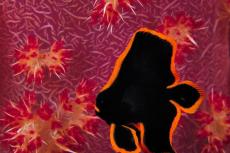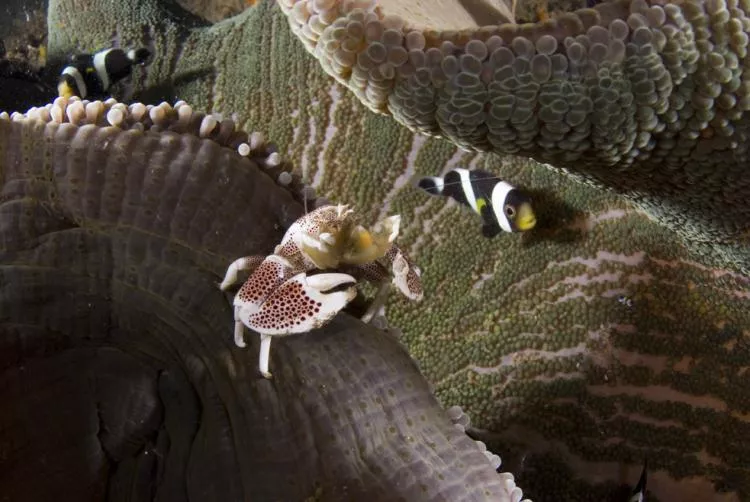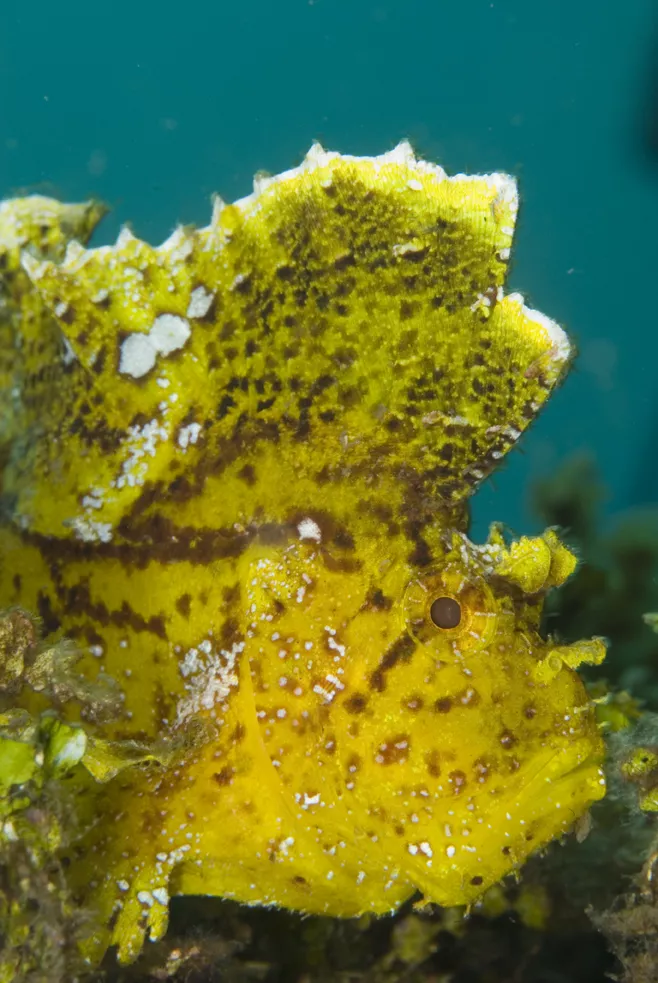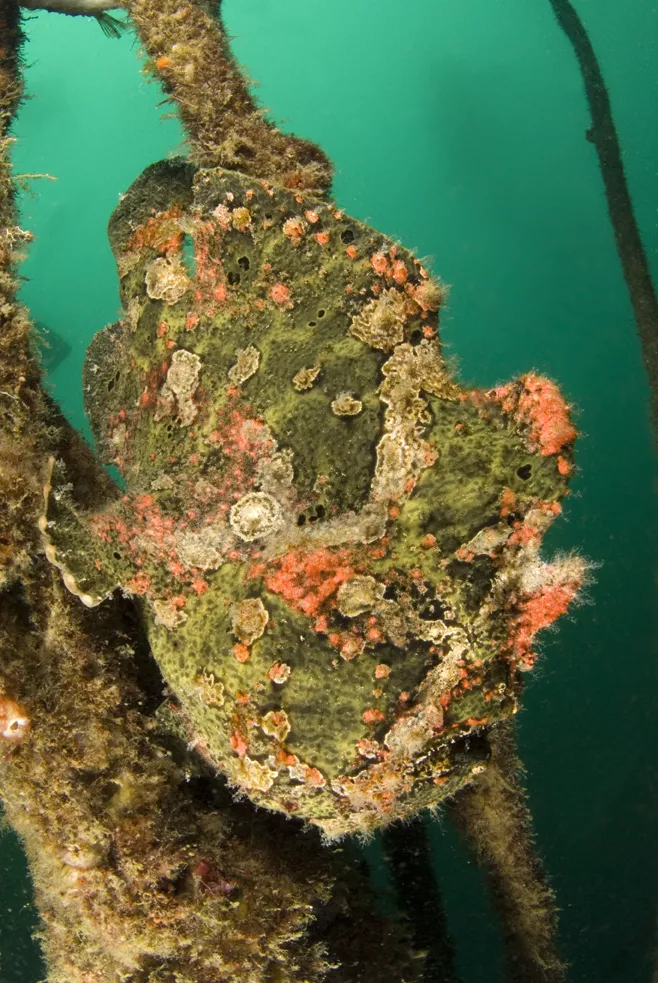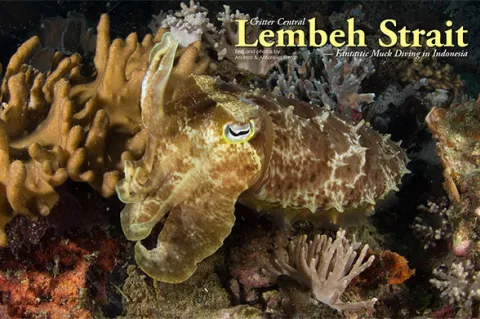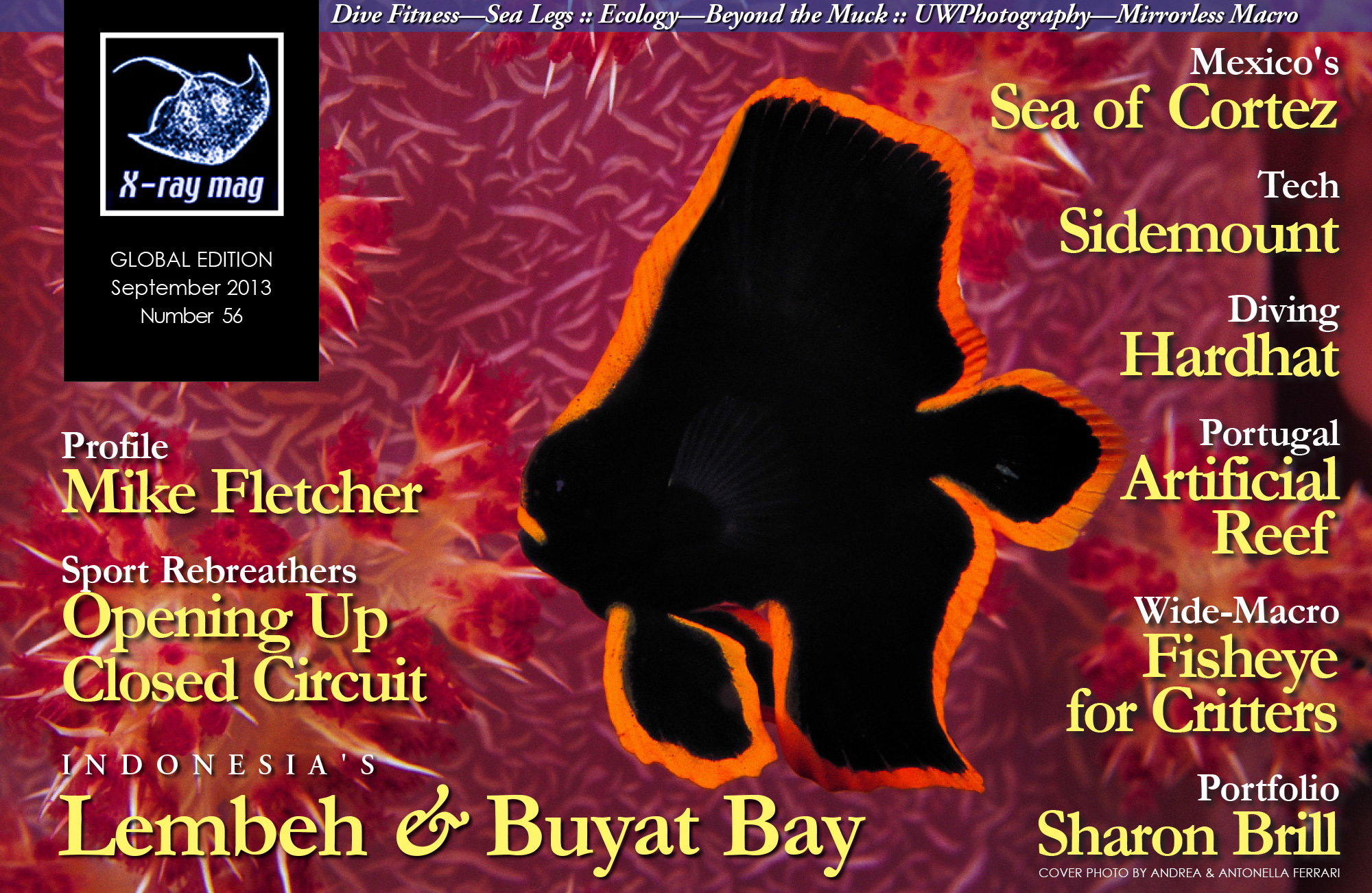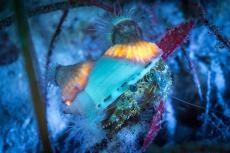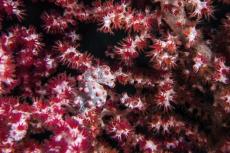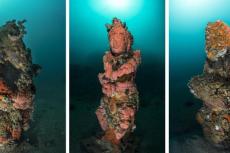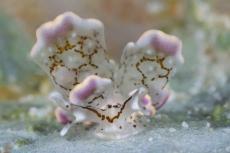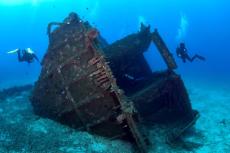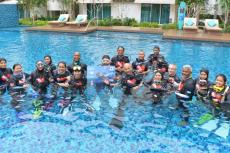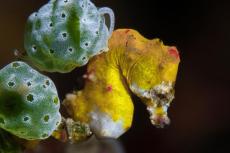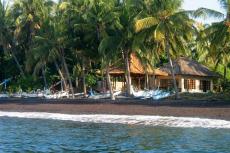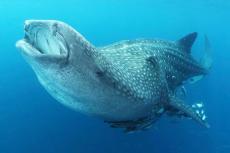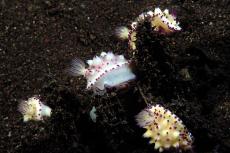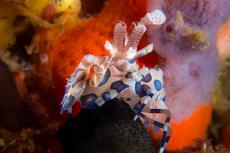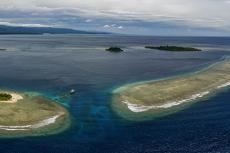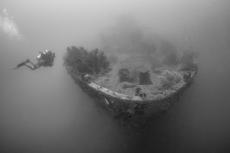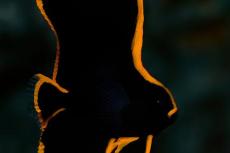The world’s full of triangles. There’s the Love Triangle, the Golden Triangle, the Bermuda Triangle… and then of course, most relevant of all to us divers, there’s the Macrolife Triangle, that blissful figure made up by the Malaysian islands of Lankayan and Kapalai and—at the northern tip of the Indonesian island of Sulawesi—the Strait of Lembeh.
Contributed by
Everybody today knows about muck diving—the concept of looking for strange and grotesque macro critters in coral-poor areas with medium or downright bad viz—but not everybody knows this is where it all began, circa 15 years ago.
A young American diver and entrepreneur just happened to discover the then-unknown place—a sea channel less than 40 meters at its deepest and less than one mile at its widest, leading from the harbor town of Bitung to the open sea on the eastern coast of Northern Sulawesi—at the same time falling in love with a plantation set in an idyllic little bay between a rugged, jungle-covered rocky slope at its back and the black volcanic sand beach on its front. Ditto, the legendary Kungkungan Bay Resort (KBR) was born!
It soon became a famed destination all over the world for unusual, spectacular species, especially for those in the most affluent areas of the United States—but the catch was in its very high price policy, which put it outside the range of common mortals.
Now, luckily for both the crowds of point-and-shoot users and the more professional DSLR underwater photographers, a new price policy put in place has given KBR a new lease of life. People are flocking to the place and its lovely bungalows by the sea, and a beautiful swimming pool has been added to the grounds.
With several more top level dive resorts now springing up close by and the Lembeh Strait soon to be declared a Marine National Park by the Indonesian authorities, the future of this very special dive destination seems at last truly assured.
A unique location
What is so special about the place? Well, everything. KBR, being the first dive resort, was able to pick the best location, and its setting is truly idyllic. The surrounding panorama above water is simply enchanting, with steep, rocky slopes covered in thick greenery, sea eagles soaring above and colorful local fishing boats passing by.
But it’s the diving which makes Lembeh so unique. Being close to a very deep water area featuring daily cold-water upswellings, the sandy and silty sea bottoms of the Strait of Lembeh host an enormous variety of rare species, which are common here but almost unheard of eveywhere else.
Even common species here come in dazzling and unique color phases, this fact being due both to the dark volcanic sand on which they live and some other undiscovered factor. The weird, the grotesque, the rare and the downright absurd are a daily occurence at its dive sites.
This is a destination where it’s not uncommon to find holy grails like weedy and paddle-flap rhinopias, Ambon scorpionfish, mimic octopus and wonderpus, pygmy seahorses, blue-ring octopus, hairy octopus, flamboyant cuttlefish, boxer crab and tiny orange-rimmed baby batfish on a daily or weekly basis—it’s a place where after a few days, it’s easy to become so spoilt that you’ll just give a passing glance and no more to uncommon species like painted and clown frogfish, thorny seahorse, cockatoo waspfish or mandarinfish.
But that is not all, as the Lembeh Strait, which has become so famous for its world-class muck diving, offers in fact first-rate coral reef dives on quite a few spots, such as Angel’s Window or California Dreaming. We know. We’ve been able to photograph there some very rare species of butterflyfish and wrasse we’d never seen anywhere else!
In any case, and whatever you’re looking for (well, except for big sharks—but in fact we have seen large eagle rays there!) the Lembeh Strait offers unsurpassed photographic opportunities.
The diving is very, very easy—shallow water, no currents, unbelievably good and very experienced dive guides. Most dive sites are just a few minutes away by KBR’s speedboats—and after night dives (something you do not want to miss here!) you’ll always find a warm, dry towel and a mug of hot chocolate waiting for you back on the boat.
KBR and the other resorts normally offer three daily dives—two in the morning and one in the early afternoon, plus night dives and unlimited house reef diving. Groups are kept to a minimum—no more than four divers for each guide (in some resorts no more than three), for maximum freedom and photo opportunities.
Given the tight dive schedules (and the longer than usual dives you’ll be enjoying, even if the official limit is 45 minutes) being on time at dive boat departure time is of paramount importance for everybody, so be punctual.
One last recommendation: the fascinating array of Lembeh marine species requests some reading beforehand to be fully understood and appreciated, so be good and do your homework. There’s plenty of great guidebooks out there to prepare you for this bit of underwater paradise!
A fragile ecosystem
The Lembeh Strait is an almost unique ecosystem, and as such it deserves all the protection we can give it. While most resorts are today enforcing a strict no-gloves dive policy (something we actually do not agree with, as we believe fingertip control can actually avoid damage by clumsy divers—it also seems a rather ridiculous request when in the Lembeh Strait one mostly dives in, well, garbage) it is a fact that the success of the place has led to an exponential increase in the numbers of resorts and consequentially visiting divers.
Some dive sites—especially the most famous ones—risk being overdived, provoking the disappearance of those same rare species people are coming to see. Declaring the area to be a National Park soon is very good news indeed, but at the same time it is imperative for all the dive operators in the area to agree on common, strict rules: divers, especially photographers, must learn not to pester their dive guides with obsessive requests (which will lead to excessive disturbance of the environment to satisfy their gluttony) and a firm rotation on the most frequently visited dive sites like Hairball, Jahir or Nudi Falls must be enforced as soon as possible.
Lembeh is a fragile masterpiece, and none of us wants to see it broken to pieces by visiting, uneducated divers or overenthusiastic dive operators.
General information
Kungkungan Bay Resort (www.kungkungan.com) and several other dive resorts on the Lembeh Strait can be easily reached with a couple of hours drive from Manado. Your travel operator will arrange everything from you.
One word of advice: water temperature in the Lembeh Strait is appreciably lower on average than the rest of Indonesia (think 24-27°C) so a 5mm wetsuit or a vest under a 3mm wetsuit will be handy. A full hood will also help in avoiding head- and neck-aches in the cold water.
Stinging hydroids are also prevalent on several dive sites, so be prepared to get stung and avoid touching anything underwater. KBR offers a mosquito-screened camera room by the dive center where shutterbugs can leave their equip-ment overnight to dry and reload batteries. Power is on 24 hours a day; 220 and 110 volts are both available.
Dive guides—especially the younger guys—are generally eagle-eyed and highly motivated, being very proud of working here. This is a place where a good tip is mandatory.
No visas are needed upon entry in Indonesia, but nationals of several western countries have to pay a hefty fee in Manado Sam Ratulangi Airport’s immigration office both when entering and exiting the country.
Land excursions
Northern Sulawesi encompasses a large area of exceptional natural beauty, with breathtaking landscapes and unique fauna. Divers have the bad habit of seldom looking around when on holiday, but on this occasion, it would really be a pity not to engage in some hiking or car touring, especially since most dive resorts readily offer affordably-priced excursions with excellent English-speaking guides and extremely comfortable transportation.
Two destinations the discriminating traveller cannot afford to miss while in the are Tangkoko National Park and the Minahasan highlands. The first can be reached by a one- or two- hour scenic drive from most resorts in the Lembeh Strait and then can easily be visited on foot.
The coastal lowland deciduous forest is the home of at least three large troops of the endemic and highly sociable black or Sulawesi macaque (Macaca nigra) and the haunt of several family groups of the fascinating Sulawesi tarsier (Tarsium spectrum), the smallest primate in the world, which lives inside the hollow trunks of strangling figs and which can be reliably observed at several locations inside the park at twilight. Longer (from three to five hours) hikes in the forest will also result in sightings of shy but spectacular hornbills, reptiles and insects.
The second trip lasts all day and will take you to the cool and beautiful Minahasan highlands, rich in local culture and scenic landscapes. One of the highlights of the excursion is the midday visit to the colorful and noisy local market at Tomohon, which offers many interesting opportunities to photographers.
Just make sure to avoid the “meat” section of the market, where unaware visitors will be faced by the gruesome and heart-rending spectacle of desperately yelping dog puppies being slaughtered for the table, together with roadside stands offering kebabs of freshly grilled jungle rats and half-roasted, scorched fruit bats. Telling your guide in advance will guarantee you’ll be spared most of these shocking sights if you—like us—would rather avoid facing them.
Besides the market, you’ll also enjoy spectacular sights of rice paddies, terraced cultivations and jade-green volcanic lakes. The local Minahasans inhabiting this verdant, fertile area are very active in farming, pottery making and wood-working. They are also quite good looking, exceptionally friendly and said by other Indonesians to be of Cambodian origin. ■
Andrea and Antonella Ferrari are widely-published dive writers and underwater photographers based near Milan, Italy, who have authored several dive guides and books on dive travel. For more information, visit: Animamundimag.com


